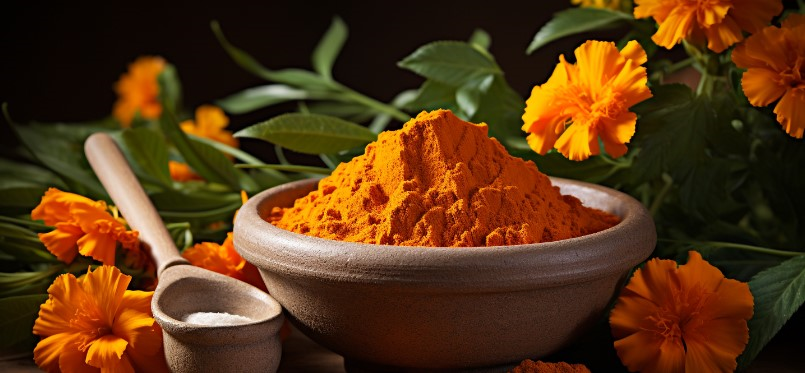Marigold Flower Extract Lutein and health

ルテイン, also known as phytolutein, caroteol, riboflavin, marigold anthocyanins, and plant lutein, is an oxygen-containing carotenoid and the main component of plant pigments in corn, vegetables, fruits, flowers, etc. , but has no vitamin A activity.
Lutein molecules have a highly unsaturated structure and are unstable to light, heat and ultraviolet rays. Lutein in most fruits is often combined with lipids to form lutein esters. There is an efficient hydrolytic esterification system in the human digestive tract that can decompose leaves. Lutein esters release free lutein, so lutein esters are one of the safe sources of lutein.
Lutein often coexists with ゼアキサンチン in nature. The chemical structures of the two are very similar and have the same number of double bonds. Only the position of one of the double bonds is different. This double bond in lutein forms an allyl hydroxyl end, making it more chemically active. ; The corresponding double bonds in zeaxanthin form a conjugated system with adjacent linear double bonds.
Lutein Antioxidant
Lutein has strong antioxidant capacity and can effectively quench singlet oxygen. The total antioxidant capacity of lutein is 50 times and 75 times that of astaxanthin and canthaxanthin. Lutein extracted from egg yolk The ability of beta-carotene to scavenge diphenylpicrylhydrazine free radicals (DPPH) is 10 times greater than that of β-carotene.
Epidemiological studies have found that lutein is negatively correlated with the risk of cardiovascular disease and some cancers, and its mechanism may be related to its antioxidant function. In addition, lutein has antioxidant, lipoxygenase inhibitor, and anti-inflammatory functions, which can reduce erythema, aging, skin burns, and even skin cancer caused by ultraviolet rays on the skin.
ルテイン Retinal protective effect
Lutein accumulates in high concentrations in the macular area (the area with the sharpest vision), with a concentration of 1 to 12 pmol/mm², and is the main pigment of the retinal macula. Because the absorption peak of lutein corresponds to the blue light absorption spectrum, it can absorb a large amount of blue light, which is equivalent to forming an effective blue light filter inside the retina of the human eye.
An intervention trial on people in working and living environments who were exposed to screen light radiation for a long time found that the contrast sensitivity, glare sensitivity and other visual function indicators of the lutein supplementers were significantly improved compared with those before the lutein intervention and the control group. , and is positively correlated with dose.
A study by Florida and others found that after 6 months of using lutein supplements of 2.4 mg/d, the lutein content in the blood increased by 130%, and the macular density in the eyes of the subjects also increased by 14%. If it was increased to 30 mg/d , after 5 months, the lutein content of the subject’s retinal macula increased by 20% to 40%. And as the lutein content in the blood increases, the risk of age-related macular degeneration can be significantly reduced.
ルテイン is related to the risk of various chronic diseases
A large number of studies have shown that lutein has an impact on cardiovascular diseases, tumors, diabetes, Alzheimer’s disease and other diseases. Most of the specific mechanisms are related to antioxidant and retinal protection.
For example, lutein can effectively inhibit oxidative stress damage caused by chronic high sugar, interrupt various inflammatory reactions caused by oxidative stress, alleviate endothelial cell apoptosis, and reduce the damage of high blood sugar to fundus blood vessels, thereby playing a role in Protect retinal function.
In recent years, it has been reported that lutein is the most important carotenoid in the cognitive and memory areas of the brain, and lutein levels in the brain are related to cognitive function. Serum lutein levels in patients with severe Alzheimer’s disease were significantly lower than those in patients with mild Alzheimer’s disease and healthy volunteers, and those with low Mini Mental State Examination scores also had relatively lower serum lutein levels.
In a double-blind placebo-controlled trial of three groups, lutein (12 mg/d), DHA (800 mg/d) and a combination group, women were tested for 4 months. Verbal fluency scores improved significantly. Memory scores and learning rates improved significantly in the combined treatment group, and they also showed a trend toward more efficient learning.
Main food sources of ルテイン
Lutein mainly exists in plant foods. The content in marigold (also known as marigold) is as high as 1.6%, and it is easy to isolate and purify. Corn has the highest lutein content (accounting for 60% of the total carotene).
In addition, vegetables and fruits with darker colors are also rich in content, such as dark green leafy vegetables such as kale and spinach, and yellow-orange fruits such as peaches, papayas, and citrus. Fruits such as peaches, grapes, and citrus are also rich in leaf yellow. Plain ester.
Natural lutein is mainly found in animal foods such as eggs and milk. Although the lutein content in eggs is not high, its bioavailability is high, 3 times that of the same amount of vegetables.
Marigold Extract Lutein Manufacturer /lutien Manufacturers/ lutien powder Supplier /lutein Suppliers/lutein Factory:バックビタ・バイオテック社
Lutein supplier: www.backvita.com
Eメール:[email protected]
電話番号+86 (029) 8187 2325
参考文献
[1] Chinese Nutrition Society. Reference intake of dietary nutrients for Chinese residents. Beijing: Science Press, 2014. [2]Bone, et al. “Lutein and Zeaxanthin Dietary Supplements Raise Macular Pigment Density and Serum Concentrations of these Carotenoids in Humans. ” Journal of Nutrition (2003). [3]Yu-Ping, Jia , et al. “The Pharmacological Effects of Lutein and Zeaxanthin on Visual Disorders and Cognition Diseases.” Molecules, 22.4(2017).
() ()